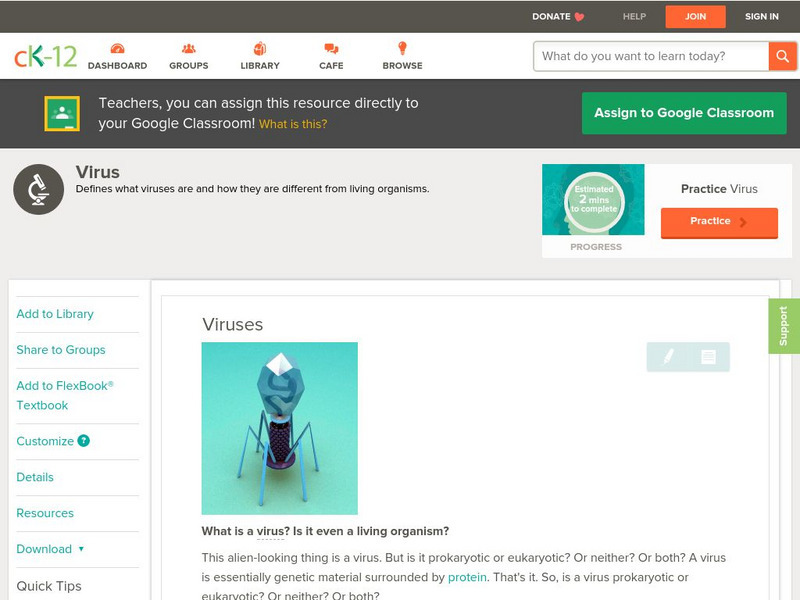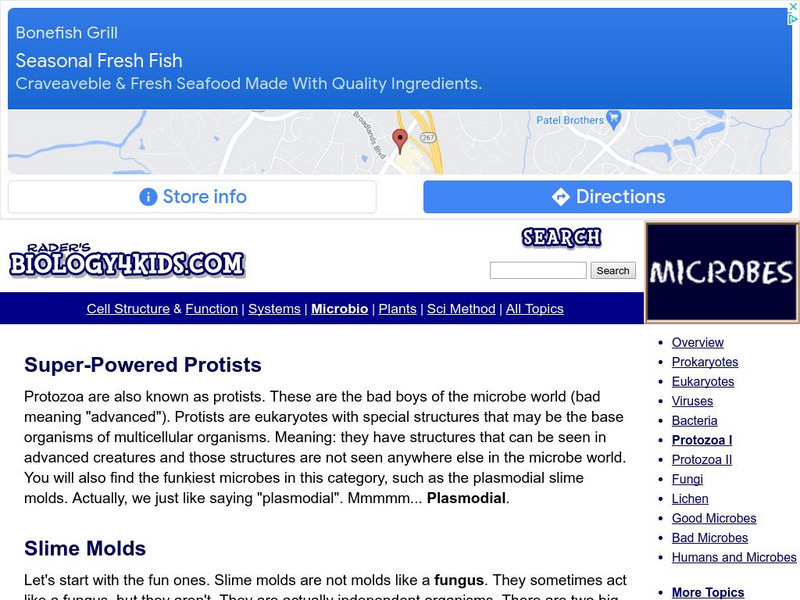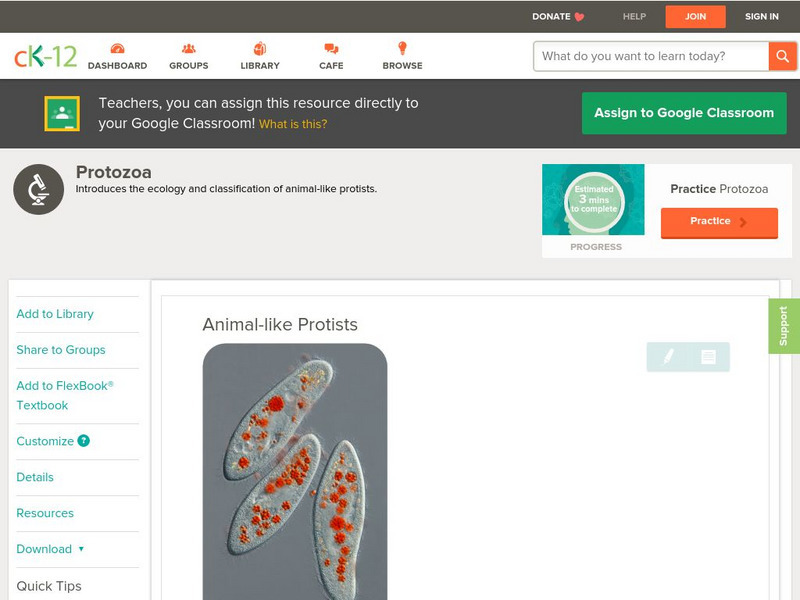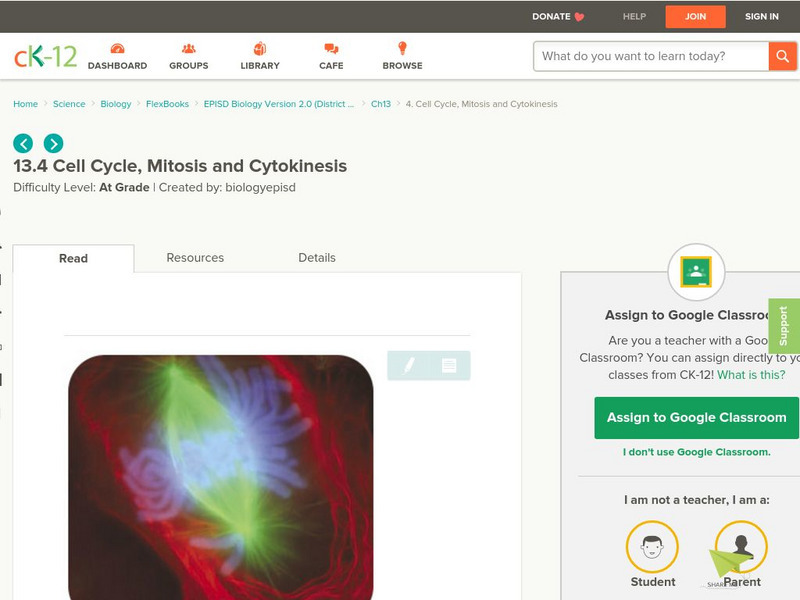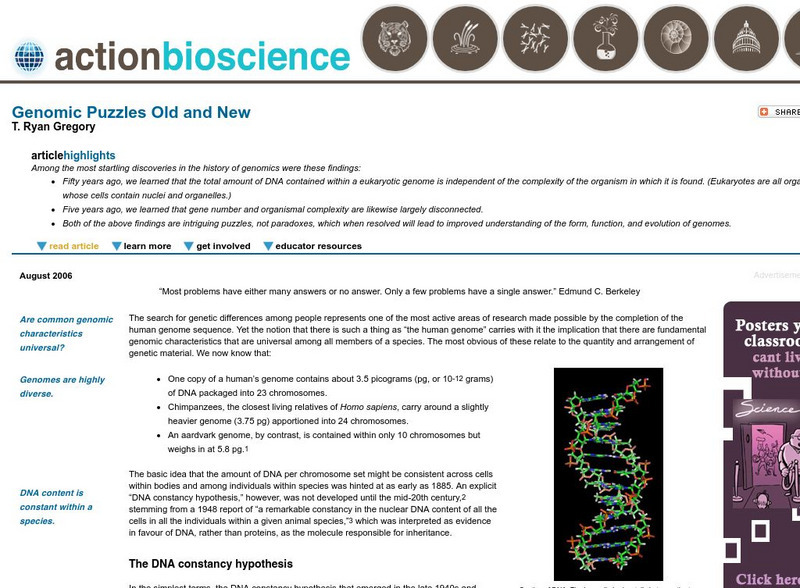CK-12 Foundation
Ck 12: Biology: Viruses
[Free Registration/Login may be required to access all resource tools.] Introduction to the properties of viruses.
BiologyWise
Biology Wise: Similarities Between Plant and Animal Cells
Presents labeled illustrations of a plant cell and an animal cell which demonstrate the parts that are common and different. Next is a table listing cell organelles and stating whether each is present or absent in a plant or animal cell....
BiologyWise
Biology Wise: How Does Autophagy Occur in a Cell
The different types of autophagy are broken down and described, including macroautophagy, microautophagy, and chaperone-mediated autophagy. The role of autophagy in cell death is also discussed.
BiologyWise
Biology Wise: Information About Animal Cells
Explains the differences between eukaryotic and prokaryotic cells and presents a diverse set of facts about animal cells.
Biology 4 kids
Biology4 Kids: Super Powered Protists
Meet the "big guys" on campus. Protists are the more advanced types of eukaryotes that are unique such as amoeba and slime molds.
CK-12 Foundation
Ck 12: Life Science: Animal Like Protists
[Free Registration/Login may be required to access all resource tools.] Animal-like protists are called protozoa. Protozoa are single-celled eukaryotes that share some traits with animals. Like animals, they can move, and they are...
Sophia Learning
Sophia: Nucleus
Learn the basic structure and function of the nucleus, or the control center of a eukaryotic cell.
BiologyWise
Biology Wise: Rough Endoplasmic Reticulum
The endoplasmic reticulum is found in eukaryotic cells and has three layers. Proteins are synthesized in the rough endoplasmic reticulum and its structure and functions are described here.
BiologyWise
Biology Wise: The Smooth Endoplasmic Reticulum and Its Functions
The endoplasmic reticulum is found in eukaryotic cells. The characteristics and functions of the smooth endoplasmic reticulum are described and it is then compared with the rough endoplasmic reticulum.
Science4Fun
Science4 Fun: Cell
Gather information about prokaryotic and eukaryotic cells and also the main parts and organelles of a cell.
BiologyWise
Biology Wise: A Brief Comparison of Plant Cell vs. Animal Cell
Presents labeled illustrations of a plant cell and an animal cell which demonstrate the parts that are common and different. This is followed by a discussion of their similarities and then of their differences.
BiologyWise
Biology Wise: Multicellular vs. Unicellular Organisms
Describes the characteristics of unicellular and multicellular organisms and gives examples for each.
BiologyWise
Biology Wise: Types of Protists
Explains what types of organisms are in the kingdom Protista and describes the different types of protists in five broad categories and in their sub-categories.
Florida State University
Florida State University: Plasma Membrane
Comprehensive description and graphic of plasma membrane of prokaryotic and eukaryotic cells.
Smithsonian Institution
National Museum of Natural History: Paleobiology: The Proterozoic Eon
Journey into the past while reading this comprehensive overview of the Proterozoic Eon that covers topics such as the Prokaryotic life, Eukaryotes, glaciation, fauna evidence, and multicellular life forms.
CK-12 Foundation
Ck 12: Cell Cycle and Cancer
[Free Registration/Login may be required to access all resource tools.] Cell division is just one of several stages that a cell goes through during its lifetime. Students will learn about the phases of the cell cycle, specifically the...
CK-12 Foundation
Ck 12: Cell Cycle, Mitosis and Cytokinesis
[Free Registration/Login may be required to access all resource tools.] A description of the stages of eukaryotic cell division, a summarization of mitosis and the metaphase plate, an explanation of the function of the centrioles and the...
Florida State University
Florida State University: Molecular Expressions Cell Biology: Animal Cell Structure
Site highlights the various features of an animal cell. Presents users with a colorful diagram depicting the anatomy of the animal cell. Provides links to obtain more detailed information about the various components found in animal cells.
PBS
Pbs Learning Media: Animal and Plant Cell
Think you can tell a yam from a yak? Examine these still images of typical plant and animal cells from Biology by Kenneth R. Miller and Joseph Levine. What similarities and differences can you find?
Georgia Department of Education
Ga Virtual Learning: Biology: Cells
A complete, interactive course where students analyze the nature of the relationships between structures and functions in living cells.
University of California
Ucmp: Cyanobacteria
General information on the cyanobacteria, the blue-green algae and the features that make them different from prokaryotic bacteria. Also included are pages that point to more specific info, like life history and fossil records.
University of California
Ucmp: Introduction to the Archaea
Berkley offers an introduction to archaebacteria--ancient bacteria--including the history of the topic, scientific findings, and where to find archaeans. Includes images and links.
American Institute of Biological Sciences
Action Bioscience: Genomic Puzzles Old and New
An explanation of genomes in regards to the amount of DNA compared to the number of chromosomes in different organisms. Additional discussion focuses on how the human genome is different from other species.
Other popular searches
- Prokaryotes and Eukaryotes
- Prokaryotes vs Eukaryotes
- Prokaryotes vs. Eukaryotes
- Prokaryotes Eukaryotes
- Gene Expression Eukaryotes
- Eukaryotes Verses Prokaryote
- Cells Eukaryotes
- Origrn of Eukaryotes
- The Function Eukaryotes
- Function Eukaryotes
- Eukaryotes Poems
